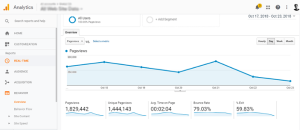
Google announced some exciting changes to its PPC platform known as AdWords at a recent developers conference. While the demise of pay-per-click advertising has been hyped in the last few years, the new changes to Google’s advertising platform will help advertisers achieve important business objectives. These Google AdWords changes range from making ads more prominent to the way that Google measures an advertisement’s performance. We’ll take a look at the most important changes, and how they can help improve your business.
Change 1: Increased Ad Size
Google has followed the same format for its text ads over the last 10 years. Text ads were limited to one headline of 25 characters and two description lines of 35 characters each. These restrictions often made it difficult for advertisers to develop compelling ads; the shorter ad format, when compared to the longer organic listing format, made paid ads more obvious. Coupled with the lack of context, paid ads were less appealing to click on when compared to organic results.
To help marketers create compelling ads with more information, Google announced that it was changing its ad format to two headlines of 30 characters and one description line of 80 characters, an increase of nearly 50 percent. With 45 extra characters between the headline and description, ads now appear similar to organic listings and can be more descriptive in nature.
Change 2: Conversions
The way that Google reports the effectiveness of your PPC ads is another change that can help marketers better measure return on investment. In the past, Google AdWords reported conversions on a “per click” basis. This meant that if a consumer clicked on an ad and took the predefined action that the marketer set up as a conversion goal, a “converted click” was counted.
But what would happen if that consumer completed three conversion opportunities? Under the “converted click” metric, only one converted click would be counted, regardless of the number of conversions that one consumer completed. This was the inherent problem that Google recognized with this outdated metric. Marketers often set up multiple conversion opportunities, and consumers can convert more than once after clicking on an advertisement.
Not only will marketers be able to count individual conversions and assign a unique value to each conversion opportunity, but they will now also get to define actions (for example, clicking on a button) and app downloads as conversions. These changes will help marketers more accurately measure a firm’s return on investment.
Change 3: Responsive Ads
With the changing size of device screens, creating ads that fit every device became a daunting process for many marketers. In an effort to help marketers serve their advertisements to more people on a range of different devices, Google has introduced responsive ads. Easy to create, these ads only require a short 25-character and a long 90-character headline, a 90-character description, a logo and an image. With this information, Google then pieces them together like a puzzle to fit the various sizes of advertising space available across its display network.
Change 4: Local Search Ads on Google Maps
We all know from childhood that “X” marks the spot on a treasure map. That’s why Google has released local search ads and promoted pins on its Google Maps product to lead consumers to more local businesses. With this feature, businesses will be able to place a promoted pin on the location of their business and feature an ad with text and coupons within a consumer’s map.
In fact, over the next couple of years, more emphasis will be placed on the measurement of “online to offline” (in-store) conversions. Google’s “Store Visit” conversion metric will use this technology to measure a number of visitors a business receives from consumers entering a store from local search ads on Google Maps. Those businesses connected to Google Merchant Center will even be able to measure sales from these online to offline visits.
Change 5: Device Bidding (Tablet)
As consumers continue to use a variety of mobile devices for search, Google has provided the ability to target consumers by device and allows marketers to alter their bidding strategy for those devices. While this may not seem like a big deal, device bidding can allow you to create ads for specific devices, while focusing bidding strategies on those devices that deliver conversions.
Combining this new feature with Google’s existing device reports can allow you to adjust campaign bidding by device anywhere from -100 percent to +900 percent. This range in bidding allows you to “turn off” your ads for specific devices, or focus on devices that deliver more conversions.
The Future of Google Advertising Features
With the rise of ad blockers, many in the industry have prematurely signaled the end of Google’s PPC platform. However, with these changes and others on the way, these improvements will allow advertisers to gain more clicks from searchers who typically do not click on ads. In fact, early studies have shown that these changes have led to a 20 percent increase in clicks. Increased clicks, as well as improved metrics and targeting, will help marketers grow their business for years to come.
Digital & Social Articles on Business 2 Community(55)







